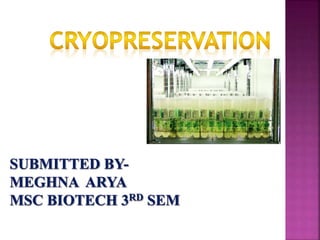
Cryop ppt
- 2. Cryo is Greek word. (krayos – frost) It literally means preservation in “frozen state.” It is a process where tissues, organelles, cells, extracellular matrix, organs or any other biological constructs susceptible to damage caused by unregulated chemical kinetics are preserved by cooling to very low temp(typically-80degree Celsius using solid carbon dioxide or -196 degree Celsius using liquid nitrogen. Cryopreservation-
- 3. The principle - to bring plant cells or tissue to a zero metabolism and non dividing state by reducing the temperature in the presence of cryoprotectant(anti freeze). It can be done : Over solid carbon dioxide (at -79 degree) Low temperature deep freezer (at -80 degree ) In vapour phase nitrogen (at -150 degree) In liquid nitrogen (at -196 degree
- 4. Until two decades ago the genetic resources were getting depleted owing to the continous depredation by man. It was imperative therefore that many of the elite, economically important and endangered species are preserved to make them available when needed. A new methodology had to be devised for long term preservation of material.
- 5. Mechanism of cryopreservation The cryopreservation technique followed by the regeneration of plants involves following steps : Selection of material Addition of cryoprotectant Freezing Storage in liquid nitrogen Thawing Washing and reculturing Measurement of viability Regeneration of plants
- 6. 1.Selection of plant material : Selection of proper plant material is important. Two important factors depend on it such as (a)nature and (b)density. Any tissue can be selected for this purpose. e.g. meristem, embryo, ovules, seeds etc..
- 7. 2. Addition of cryoprotectant They are chemical which prevent cryodestruction. These are sucrose, alcohols, glycols, some amino acid (proline), DMSO (dimethyl sulfoxide). Generally two cryoprotectant should be used together instead of single one as they are more effective.
- 8. 3. Freezing The sensitivity of cells to low temperature depends on the plant species. There are four different types of methods : Slow freezing method - the tissue or plant material is slowly frozen at slow cooling rate. The advantage is the plant cells are partially dehydrated and survive better. Rapid freezing method - it involves plunging the vials in liquid nitrogen. The temperature decreases from -300 to -1000 degree rapidly. Combine freezing method - this is combination of both slow and rapid freezing method. The process is carried out in step wise like manner. Dry freezing method - in this method dehydrated cells and seeds are stored.
- 9. 4. Storage The maintenance of the frozen cells or material at specific temperature is very important. In general the temperature is kept -70 to -196 degree. Prolong storage is done at temperature of -196 degree in liquid nitrogen. To prevent damage, continous supply of nitrogen is done.
- 10. 5. Thawing Usually carried out by plunging the vials into warm water bath with vigorous swirling. As thawing occurs the vials are transferred to another bath at 0 degree. 6. Washing and reculturing The preserved material is washed few times to remove the cryoprotectant. This material is then recultured in a fresh medium
- 11. 7. Measurement of viability There is possibility of death of cells due to storage stress. Thus viability can be found at any stage. It is calculated by formula : No of cells growing / no of cells thawed * 100 8. Plant regeneration The viable seeds are cultured on non specific growth medium. Suitable environmental conditions are maintained.
- 12. Major advantages are : 1. Once the material is sucessfully conserved to particular temperature it can be preserved indefinately. 2. Once in storage no chance of new contamination of fungus or bacteria. 3. Minimal space required. 4. Minimal labour required.
- 13. It is ideal method for long term conservation of material. Disease free plants can be conserved and propagated. Recalcitrant seeds can be maintained for long time. Endangered species can be maintained. Pollens can be maintained to increase longitivity. Rare germplasm and other genetic manipulations can be stored.